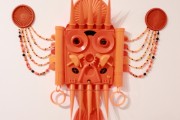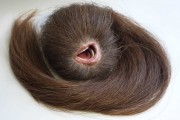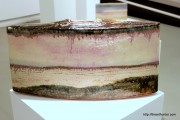Sometimes you come across an artist who is enamoured by the simple act of creating art. They live to explore the boundaries of what is possible by blending new and old techniques and styles. Andrew Dearman is one such artist whose work is exciting because he is on the cusp of this exploration. I was able to ask him a few questions, and gain a better understanding of his work.
Where are you from, have you always lived in Adelaide?
I’ve always lived in Adelaide, although I’ve travelled here and there interstate and overseas a few times.
What is your background?
I’ve always been a practicing artist in one way or another. I’ve always like making things. My day jobs have consisted of bicycle courier, data entry operator etc., but for most of the last ten years I’ve worked as a lecturer & tutor at the three main art schools in Adelaide.
Could you tell us a little about how you first became involved in Art?
I left high school as soon as I turned 15. From my experience it was quite a violent place. I started studying art and ancient history at TafeSA, although it wasn’t called that back then.
Where did you do your training?
I first studied art TafeSA, when it was in Stanley Street in North Adelaide, majoring in Sculpture. That was from 1981 through to 1984. I went back there briefly in 1989 as well. I later decided to go to SA School of Art at UniSA from 2001 to 2008. While I was there, I did the Bachelor, Honors, and then a PhD.
Where is your studio located and what is something you love about it?
I’ve had a few studios over the years. At the moment I’m at The Mill in Angas Street in the city. It’s close to where I live, but not so close that I can’t disengage myself from it. Of the studios I’ve been in, this one is certainly the most beneficial for my practice. There are a lot of other likeminded creative people here. For me, the best part about it is the diversity of the creative practices of those who have studios here. There are painters, photographers, jewelers, furniture makers, shoe makers, illustrators, choreographers, curators, and many more. This diversity takes it away from being about just the visual arts.
What is it about photography that you enjoy?
I don’t really identify as a photographer as such, even though photography is something that I’m obsessed about. I find it interesting as an art form and also as a social practice. I like that it’s an image and an object at the same time. I like that we often find it difficult to appreciate both things simultaneously. When it’s an image, it’s like a window that we look through. At other times it’s an object that we hold, look at, turn in our hand. I like the play between these two states.
Name three artists that you admire
I find it difficult at first to name three artists that I admire. It seems like a default position to go for the big art names that everyone knows about, but if I really think about it, local people come to mind as being more important.
Alice Blanch is an Adelaide based photographer who uses old Kodak Box Brownie cameras and Polaroids to produce some amazing panoramic landscapes. Her technique of winding the film on in a seemingly arbitrary fashion in producing the landscapes produces really beautiful repetitive overlaid spaces.
Henry Jock Walker is another local, who takes painting with a restricted palette of orange and blue to extremes. He moves away from two dimensions and produces works that are also sculptural and performative. He literally paints whilst surfing.
Andrew Steel is a painter that I went through art school with in the early 1980s. Although he tends to keep a low profile, his passion for and understanding of colour, shape, and texture, are possibly the strongest you’ll find anywhere.
What themes do you enjoy exploring?
I tend to explore different themes, however the one area that I seem to come back to over and over is the relationship between the painted and photographed portrait. I recently exhibited a series of old works that I made in 2002 at The Mill in Adelaide. In looking at those works, I realized that I’m still dealing with the same themes, especially in my wet plate dioramas that are made out of paper cut outs and then photographed in a little stage set.
Could you explain the process of wet plate photography and what you find fascinating about it compared to conventional or traditional darkroom photography?
Wet plate photography was one of the earliest forms of photography, invented in the 1850s. It involves pouring chemical called Collodion onto a sheet of glass or blackened metal. This is then placed in a solution of silver nitrate for three minutes, then placed in a camera and exposed. The plate is then developed.
If you over sensitize the glass plate in the solution of silver nitrate, and then overexpose and under develop it, you end up with a negative from which you can print. If you under sensitize the plate in the solution and then under expose it, you end up with a thinner image, that when placed on a black background, becomes a positive. This is called an ‘Ambrotype’. You can also make an image on a blackened sheet of metal to produce a positive image in the same way. This is usually called a ‘Tintype’, although they were rarely made on tin, and are usually made on aluminium.
For me the most interesting aspect of wet plate photography is the degree to which it’s a hands on process. Each image can take half an hour to make. I think that this means that you think more deeply and carefully about what you’re doing.
Why do you think people are starting to become fascinated with analogue photography again?
I presented a paper on this question at a conference at Aalto University in Helsinki last year, speculating on why it was that analogue process are becoming popular again. Some argue that the return to analogue is as a result of the perceived coldness of digital, that we don’t engage as much with the production of an image that has been produced primarily by a computer.
While that might be the case to a degree, I think it’s more to do with the fact that we learn about the world through handling materials. Academics like Barbara Bolt borrow the term ‘handleability’ from Martin Heidegger to explain this simple concept. Analogue processes often involve learning through touch and the movement of the hands through repetitive motion. It relates to an embodied form of knowledge.
Other academic disciplines with the social sciences have for ten to fifteen years been steadily writing more and more about what has come to be termed the ‘Material Turn’. It relates to the importance of things and objects in our daily life. A key author in the area is Jane Bennett who, like other authors, considers and object as seemingly having an internal life. While this seems like a new concept, it’s fundamental to many non-Western religious beliefs, and it is also a concept held by the Ancient Greeks. It is also a concept at the heart of Western Modern Art throughout the first half of the 20th century.
For me, the slowness of wet plate photography, it’s materiality and it’s unexpected results, gives one something of the feeling that it’s more than just an image of something—a window to be looked through. It combines both image and materiality.
Andrew Dearman links

















